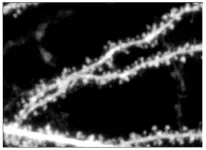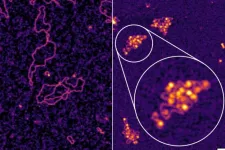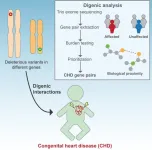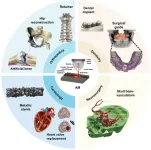(Press-News.org) Building on more than two decades of research, a study by MIT neuroscientists at The Picower Institute for Learning and Memory reports a new way to treat pathology and symptoms of fragile X syndrome, the most common genetically-caused autism spectrum disorder. The team showed that augmenting a novel type of neurotransmitter signaling reduced hallmarks of fragile X in mouse models of the disorder.
The new approach described in Cell Reports works by targeting a specific molecular subunit of “NMDA” receptors that they discovered plays a key role in how neurons synthesize proteins to regulate their connections, or “synapses,” with other neurons in brain circuits. The scientists showed that in fragile X model mice, increasing the receptor’s activity caused neurons in the hippocampus region of the brain to increase molecular signaling that suppressed excessive bulk protein synthesis, leading to other key improvements.
Setting the table
“One of the things I find most satisfying about this study is that the pieces of the puzzle fit so nicely into what had come before,” said study senior author Mark Bear, Picower Professor in MIT’s Department of Brain and Cognitive Sciences. Former postdoc Stephanie Barnes, now a lecturer at the University of Glasgow, is the study’s lead author.
Bear’s lab studies how neurons continually edit their circuit connections, a process called “synaptic plasticity” that scientists believe to underlie the brain’s ability to adapt to experience and to form and process memories. These studies led to two discoveries that set the table for the newly published advance. In 2011, Bear’s lab showed that fragile X and another autism disorder, tuberous sclerosis (Tsc), represented two ends of a continuum of a kind of protein synthesis in the same neurons. In fragile X there was too much. In Tsc there was too little. When lab members crossbred fragile X and Tsc mice, in fact, their offspring emerged healthy as the mutations of each disorder essentially canceled each other out.
More recently, Bear’s lab showed a different dichotomy. It has long been understood from their seminal work in the 1990s that the flow of calcium ions through NMDA receptor can trigger a form of synaptic plasticity called “long-term depression” (LTD). But in 2020, they found that another mode of signaling by the receptor—one that did not require ion flow—altered protein synthesis in the neuron and caused a physical shrinking of the dendritic “spine” structures housing synapses.
For Bear and Barnes these studies raised the prospect that if they could pinpoint how NMDA receptors affect protein synthesis they might identify a new mechanism that could be manipulated therapeutically to address fragile X (and perhaps tuberous sclerosis) pathology and symptoms. That would be an important advance to complement ongoing work Bear’s lab has done to correct fragile X protein synthesis levels via another receptor called mGluR5.
Receptor dissection
In the new study, Bear and Barnes’s team decided to use the non-ionic effect on spine shrinkage as a readout to dissect how NMDARs signal protein synthesis for synaptic plasticity in hippocampus neurons. They hypothesized that the dichotomy of ionic effects on synaptic function and non-ionic effects on spine structure might derive from the presence of two distinct components of NMDAR receptors: “subunits” called GluN2A and GluN2B. To test that, they used genetic manipulations to knock out each of the subunits. When they did so, they found that knocking out “2A” or “2B” could eliminate LTD but that only knocking out 2B affected spine size. Further experiments clarified that 2A and 2B are required for LTD, but that spine shrinkage solely depends on the 2B subunit.
The next task was to resolve how the 2B subunit signals spine shrinkage. A promising possibility was a part of the subunit called the “carboxyterminal domain,” or CTD. So, in a new experiment Bear and Barnes took advantage of a mouse that had been genetically engineered by researchers at the University of Edinburgh so that the 2A and 2B CTDs could be swapped with one another. A telling result was that when the 2B subunit lacked its proper CTD, the effect on spine structure disappeared. The result affirmed that the 2B subunit signals spine shrinkage via its CTD.
Another consequence of replacing the CTD of the 2B subunit was an increase in bulk protein synthesis that resembled findings in fragile X. Conversely, augmenting the non-ionic signaling through the 2B subunit suppressed bulk protein synthesis, reminiscent of Tsc.
Treating fragile X
Putting the pieces together, the findings indicated that augmenting signaling through the 2B subunit might, like introducing the mutation causing Tsc, rescue aspects of fragile X.
Indeed when the scientists swapped in the 2B subunit CTD of NMDA receptor in fragile X model mice they found correction of not only the excessive bulk protein synthesis, but also altered synaptic plasticity, and increased electrical excitability that are hallmarks of the disease. To see if a treatment that targets NMDA receptors might be effective in fragile X, they tried an experimental drug called Glyx-13. This drug binds to the 2B subunit of NMDA receptors to augment signaling. The researchers found that this treatment can also normalize protein synthesis and reduced sound-induced seizures in the fragile X mice.
The team now hypothesizes, based on another prior study in the lab, that the beneficial effect to fragile X mice of the 2B subunit’s CTD signaling is that it shifts the balance of protein synthesis away from an all-too-efficient translation of short messenger RNAs (which leads to excessive bulk protein synthesis) toward a lower efficiency translation of longer messenger RNAs.
Bear said he does not know what the prospects are for Glyx-13 as a clinical drug, but he noted that there are some drugs in clinical development that specifically target the 2B subunit of NMDA receptors.
In addition to Bear and Barnes, the study’s other authors are Aurore Thomazeau, Peter Finnie, Max Heinreich, Arnold Heynen, Noboru Komiyama, Seth Grant, Frank Menniti and Emily Osterweil.
The FRAXA Foundation, The Picower Institute for Learning and Memory, The Freedom Together Foundation and the National Institutes of Health funded the study.
END
Study suggests new molecular strategy for treating fragile X syndrome
Enhancing activity of a specific component of ‘NMDA’ receptors normalized protein synthesis, neural activity and seizure susceptibility in hippocampus of fragile X lab mice
2025-02-20
ELSE PRESS RELEASES FROM THIS DATE:
Digging into a decades-old hepatitis B mystery suggests a new potential treatment
2025-02-20
In their effort to answer a decades-old biological question about how the hepatitis B virus (HBV) is able to establish infection of liver cells, research led by Memorial Sloan Kettering Cancer Center (MSK), Weill Cornell Medicine, and The Rockefeller University identified a vulnerability that opens the door to new treatments.
The team successfully disrupted the virus’s ability to infect human liver cells in the laboratory using a compound already in clinical trials against cancer — laying the ...
Big birds like emus are technical innovators, according to University of Bristol researchers
2025-02-20
Large birds – our closest relations to dinosaurs - are capable of technical innovation, by solving a physical task to gain access to food.
This is the first time scientists have been able to show that palaeognath birds such as emus and rheas can solve tricky problems.
In the study, published today in Scientific Reports, emus, which have previously been called the ‘world’s dumbest bird’ were able to create one new technique to access food (lining up a hole with a food chamber) and moved the hole in the most efficient direction towards food in 90% of cases. A male rhea ...
Hidden genetic causes of congenital heart disease identified
2025-02-20
New York, NY [February 20, 2025]—Scientists at the Icahn School of Medicine at Mount Sinai and collaborators have identified novel genetic interactions that may contribute to congenital heart disease (CHD), a common birth defect. Details on their findings were reported in the February 20 online issue of The American Journal of Human Genetics [DOI: 10.1016/j.ajhg.2025.01.024].
“Our research reveals the potential for digenic inheritance—where two genes work together to cause disease—expanding our understanding of the genetic underpinnings of congenital heart ...
Semaglutide and nonarteritic anterior ischemic optic neuropathy
2025-02-20
About The Study: The results of this study suggest a modest increase in the risk of nonarteritic anterior ischemic optic neuropathy among individuals with type 2 diabetes associated with semaglutide use, smaller than that previously reported, and warranting further investigation into the clinical implications of this association.
Corresponding Author: To contact the corresponding author, Cindy X. Cai, MD, MS, email ccai6@jhmi.edu.
To access the embargoed study: Visit our For The Media website at this link https://media.jamanetwork.com/
(doi:10.1001/jamaophthalmol.2024.6555)
Editor’s ...
Inequities in the application of behavioral flags for hospitalized pediatric patients
2025-02-20
About The Study: This cohort study found significant inequities in incidence of behavioral flags in the electronic health record among racially and socioeconomically marginalized pediatric patients. This finding was most pronounced for Black or African American patients younger than 8 years, suggesting that this phenomenon may be a response to Black families rather than specific patient behavior.
Corresponding Author: To contact the corresponding author, April Edwell, MD, MAEd, email April.edwell@ucsf.edu.
To access the embargoed study: Visit our For The Media website at this link https://media.jamanetwork.com/
(doi:10.1001/jamanetworkopen.2024.61079)
Editor’s ...
Paxlovid’s impact on hospitalization and death in COVID-vaccinated older adults far weaker than previously thought
2025-02-20
Paxlovid does not significantly reduce COVID-19 hospitalization and mortality among vaccinated older adults, according to new UCLA-led research.
The study questions the assumption that Paxlovid’s effectiveness in reducing COVID-19 hospitalizations and deaths in unvaccinated adults also applies to vaccinated adults. Pfizer’s 2022 clinical trial found reduced COVID-19 hospitalization in unvaccinated middle-aged adults; while a subsequent 2024 clinical trial found no significant reduction in vaccinated middle-aged adults. Since most older Americans have already received two or more COVID-19 vaccines, Paxlovid’s effectiveness on vaccinated ...
Additive manufacturing of biomedical metals for medical implant fabrication
2025-02-20
Biomedical metal implant materials are widely used in clinical applications, including dental implants, hip replacement, bone plates, and screws. However, traditional manufacturing processes face limitations in meeting customized medical needs, internal structural control, and efficient material utilization. For example, when producing complex-shaped titanium alloy parts using conventional methods, the material consumption ratio is as high as 10:1-20:1, leading to significant material waste.
As a result, ...
Antioxidant-enzyme Interaction in non-communicable diseases
2025-02-20
Introduction
Oxidative stress, caused by an imbalance between reactive oxygen species (ROS) and antioxidant defenses, plays a central role in the development of non-communicable diseases (NCDs). These diseases, including cardiovascular disorders, diabetes, neurodegenerative conditions, cancer, and liver and kidney diseases, are among the leading causes of morbidity and mortality worldwide. Enzymatic and non-enzymatic antioxidants serve as the body’s primary defense against ROS, maintaining redox homeostasis and preventing cellular damage. However, when ROS levels exceed the capacity of antioxidant defenses, oxidative stress ensues, contributing ...
Turtles change nesting patterns in response to climate change
2025-02-20
New research shows that turtles are responding to climate change by nesting earlier.
Researchers monitoring nesting green and loggerhead turtles in Cyprus have discovered they are returning to their regular nesting spots earlier each year to compensate for rising temperatures.
In sea turtles, temperature determines the biological sex of offspring, with more females born when it is warmer, as well as fewer successful hatchings when it gets too hot.
Turtles also have “natal philopatry”, which means they return to nest in the area where they themselves hatched.
A research team from the University of Exeter and the Society for the Protection of ...
New research links grape consumption to improved muscle health in both men and women
2025-02-20
A new study from Western New England University (WNE) has revealed that long-term grape consumption significantly impacts muscle health, with notable benefits for both men and women. The research, published in the journal Foods, suggests that a diet including grapes can modify gene expression in muscle, potentially offering a new nutritional strategy for maintaining muscle mass and function.
Around 30 million tons of grapes are consumed every year, and their benefits extend beyond nutrition. Grapes have been shown to ...
LAST 30 PRESS RELEASES:
Making lighter work of calculating fluid and heat flow
Normalizing blood sugar can halve heart attack risk
Lowering blood sugar cuts heart attack risk in people with prediabetes
Study links genetic variants to risk of blinding eye disease in premature infants
Non-opioid ‘pain sponge’ therapy halts cartilage degeneration and relieves chronic pain
AI can pick up cultural values by mimicking how kids learn
China’s ecological redlines offer fast track to 30 x 30 global conservation goal
Invisible indoor threats: emerging household contaminants and their growing risks to human health
Adding antibody treatment to chemo boosts outcomes for children with rare cancer
Germline pathogenic variants among women without a history of breast cancer
Tanning beds triple melanoma risk, potentially causing broad DNA damage
Unique bond identified as key to viral infection speed
Indoor tanning makes youthful skin much older on a genetic level
Mouse model sheds new light on the causes and potential solutions to human GI problems linked to muscular dystrophy
The Journal of Nuclear Medicine ahead-of-print tip sheet: December 12, 2025
Smarter tools for peering into the microscopic world
Applications open for funding to conduct research in the Kinsey Institute archives
Global measure underestimates the severity of food insecurity
Child survivors of critical illness are missing out on timely follow up care
Risk-based vs annual breast cancer screening / the WISDOM randomized clinical trial
University of Toronto launches Electric Vehicle Innovation Ontario to accelerate advanced EV technologies and build Canada’s innovation advantage
Early relapse predicts poor outcomes in aggressive blood cancer
American College of Lifestyle Medicine applauds two CMS models aligned with lifestyle medicine practice and reimbursement
Clinical trial finds cannabis use not a barrier to quitting nicotine vaping
Supplemental nutrition assistance program policies and food insecurity
Switching immune cells to “night mode” could limit damage after a heart attack, study suggests
URI-based Global RIghts Project report spotlights continued troubling trends in worldwide inhumane treatment
Neutrophils are less aggressive at night, explaining why nighttime heart attacks cause less damage than daytime events
Menopausal hormone therapy may not pose breast cancer risk for women with BRCA mutations
Mobile health tool may improve quality of life for adolescent and young adult breast cancer survivors
[Press-News.org] Study suggests new molecular strategy for treating fragile X syndromeEnhancing activity of a specific component of ‘NMDA’ receptors normalized protein synthesis, neural activity and seizure susceptibility in hippocampus of fragile X lab mice







